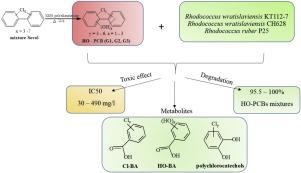Journal of Hazardous Materials ( IF 12.2 ) Pub Date : 2020-06-26 , DOI: 10.1016/j.jhazmat.2020.123328 Darya O Egorova 1 , Tatyana I Gorbunova 2 , Marina G Pervova 2 , Tatyana D Kir'yanova 1 , Vitalyi A Demakov 1 , Viсtor I Saloutin 2 , Oleg N Chupakhin 2

|
For the first time, investigations are is carried out for the interactions of hydroxylated polychlorobiphenyls (HO-PCBs) mixtures, which were obtained from PCBs commercially available under the trade name Sovol, with the Rhodococcus (R.) strains. It is established that the HO-PCBs mixtures containing basic products within the range of 83.2 – 95.8% cause a toxic effect on the growth of R. wratislaviensis KT112-7, R. wratislaviensis CH628, R. ruber P25 strains. The inhibitory concentration (IC50) was varied within the range of 30 – 490 mg/l. For the first time, it is found that the bacterial strains can use HO-PCBs as a source of carbon with no co-substrate added. The strains are shown to degrade 95.5 – 100% of the HO-PCBs mixtures at a concentration of 0.1 g/l during 14 days. It is demonstrated that HO-PCBs degrading occurs following the classical bacterial pathway of transforming biphenyl/PCB. However, the HO-PCBs metabolites, which are substituted benzoic acids, are not the final products of the transformation and are subjected to further degrading by the strains. Therefore, the R. wratislaviensis KT112-7, R. wratislaviensis CH628, and R. ruber P25 strains are shown to degrade the HO-PCBs mixtures efficiently and are found to be stable to their toxic action.
中文翻译:

红球菌菌株对商业多氯联苯混合物的羟基化衍生物的生物降解能力。
首次进行了羟基化多氯联苯(HO-PCBs)混合物的研究,该混合物是从商品名为Sovol的多氯联苯中获得的,与Rhodococcus(R.)菌株之间的相互作用。已经确定,含有83.2 – 95.8%范围内基本产物的HO-PCBs混合物会对罗拉氏罗非鱼KT112-7,罗拉氏罗非鱼CH628,罗氏橡胶的生长产生毒性作用。P25菌株。抑制浓度(IC50)在30 – 490 mg / l的范围内变化。首次发现细菌菌株可以使用HO-PCBs作为碳源,而无需添加共底物。结果表明,在14天内,菌株以0.1 g / l的浓度降解了95.5 – 100%的HO-PCBs混合物。结果表明,HO-PCBs的降解遵循联苯/ PCB转化的经典细菌途径。但是,HO-PCBs的代谢产物是取代的苯甲酸,不是转化的最终产物,并且会因菌株而进一步降解。因此,R。wratislaviensis KT112-7,R。wratislaviensis CH628和R. ruber 已显示P25菌株可有效降解HO-PCBs混合物,并发现对其毒性作用稳定。











































 京公网安备 11010802027423号
京公网安备 11010802027423号